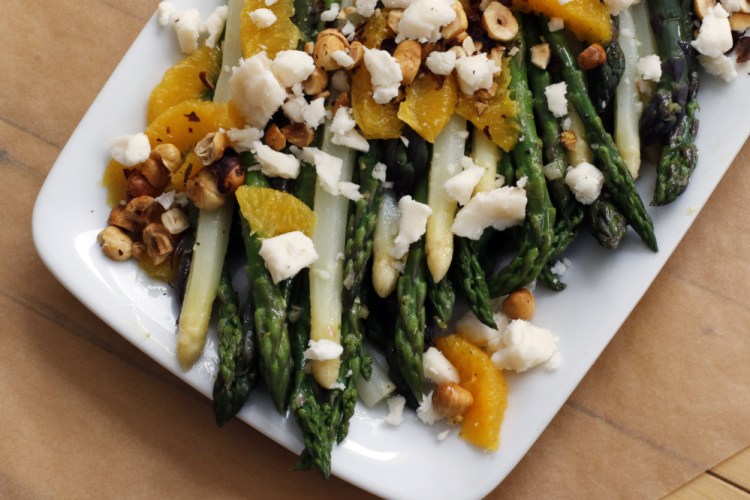Here in America we think of white asparagus as the pink elephant of the vegetable world – not even a rumor so much as a hallucination.
It actually has been a staple in Europe for centuries. These days, happily enough, I’ve been spotting white asparagus more often on our side of the pond.
White asparagus is white because the spears are never exposed to sunlight as they grow. Without sunlight, they produce no chlorophyll. Without chlorophyll, they don’t turn green. White asparagus is a little milder and more delicate in flavor than the green variety. It’s also rich in nutrients and very low in calories.
At the supermarket, the best white asparagus boasts the same attributes as the best green asparagus: a firm, smooth stalk and a tight top. While I am a fan of any kind of green asparagus – be it pencil-thin or thick as a carrot – thicker is better when it comes to white asparagus.
Once you get it home, slice off the bottom half-inch of each spear, then stand the entire bunch up, cut-side down, in a glass or narrow pitcher filled with a few inches of water. Cover the tops with a plastic bag and refrigerate until you’re ready to cook them. This little trick, which works equally well with green asparagus, will keep them fresh longer.
White asparagus has a tough bitter peel. Unlike green asparagus (which I only peel when it’s more than a 1/3 inch thick), white asparagus must be peeled. Otherwise, it’s very hard to chew. Because white asparagus tends to break easily, peeling these guys requires a little extra care. You want to lay each spear on the counter. Then, using a vegetable peeler, peel it from just below the tip to the end of the stalk. Also, white asparagus takes much longer to cook than its green cousin.
I tried both steaming and boiling the asparagus and, surprisingly, found no difference in taste. I’d worried that boiling it might leave the spears waterlogged, but as long as you pull them out of the water when they’re tender, that isn’t really a problem. Lightly salting the water is key, though. The asparagus absorbs the salt, which points up its flavor, making it taste more asparagus-y. Salting it after you’ve cooked it will not have the same effect.
Given the relative subtlety of the flavor of white asparagus, I recommend pairing it with similarly subtle ingredients, ones that will harmonize with – but not overwhelm – the asparagus.
For this elegant salad, conceived as a treat for Mom on Mother’s Day, I teamed the white asparagus with an orange vinaigrette, toasted hazelnuts and aged goat cheese. If you can’t find white asparagus, don’t sweat it; this recipe will work just as well with the green or purple (but cook them for less time).
ASPARAGUS WITH ORANGE VINAIGRETTE, TOASTED HAZELNUTS AND AGED GOAT CHEESE
Makes 6 servings
⅓ cup orange juice
2 tablespoons finely minced shallots
2 tablespoons white wine vinegar
1 teaspoon Dijon mustard
¼ teaspoon kosher salt
¼ teaspoon ground black pepper
¼ cup vegetable or canola oil
2 pounds fresh white asparagus, the bottom ½ inch discarded and the spears peeled from just below the tip down the length of the stalks
1 cup fresh orange segments
2 ounces crumbled aged goat cheese
⅔ cup coarsely chopped toasted hazelnuts
Chopped fresh dill, chives or tarragon, to garnish
In a small saucepan over medium, simmer the orange juice until it is reduced to 2 tablespoons. Add the shallot, vinegar, mustard and salt and pepper. Whisk until the salt is dissolved, then add the oil in a stream, whisking. Set aside.
In a large saucepan over medium-high, bring 3 inches of salted water to a boil. Add half the asparagus and simmer for 6 to 8 minutes, or until tender (take one out, cut a piece off and taste to determine doneness). Transfer the spears to paper towels to drain, then cook and drain the remaining asparagus in the same manner.
On a large platter toss the asparagus gently with two-thirds of the dressing, then season with salt and pepper. Transfer the asparagus to plates and top each portion with some of the orange segments, cheese, nuts, herbs and a little of the remaining dressing.
Sara Moulton is the host of public television’s “Sara’s Weeknight Meals.” She was executive chef at Gourmet magazine for nearly 25 years.
Send questions/comments to the editors.



Comments are no longer available on this story